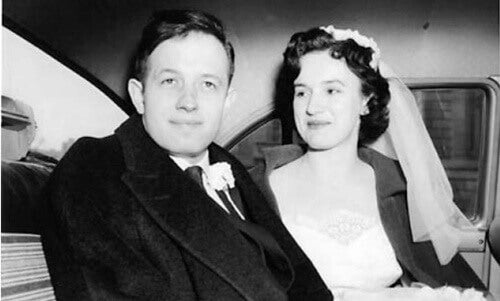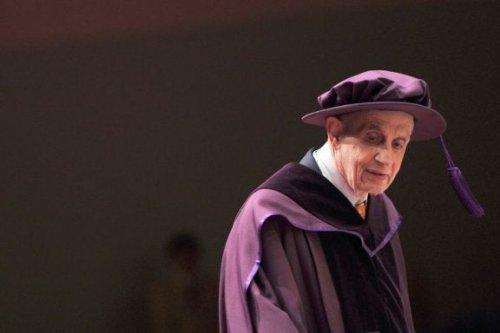John Forbes Nash - A Prodigious Mathematician


Written and verified by the psychologist Valeria Sabater
John Forbes Nash was one of the most brilliant mathematicians of the past century. He won the Nobel Memorial Prize in Economic Sciences for his game and negotiation processes theory. However, people usually remember him for his prodigious and wonderful mind. In this regard, he was able to cope with paranoid schizophrenia by being in control of his irrational thoughts.
Columbia University journalist and professor Sylvia Nasar wrote a book about Nash’s life. It was later brought to the big screen with the name A Beautiful Mind. Above all, the movie shows the most creative era of this mathematician. He was known for his erratic behavior as he wandered around the halls of Princeton University.
Some surprising facts about John Forbes Nash

Doctors diagnosed him with schizophrenia when he was 30. However, his faculties and mathematical abilities were more awake than ever throughout this period. Nash later explained that he limited himself to giving the same truth to the supernatural beings that his mind created as he did to his mathematical ideas. The two worlds diffusely overlapped but, in turn, he was amazingly creative and theoretically harmonious.
His contributions to mathematics around that time were huge. For example, his nonlinear partial derivative equations had a decisive impact on various scientific fields such as mathematics, finance, systems biology, political science, psychology, and, of course, economics.
Thus, his game theory provides you with a very valuable tool with which to try to predict how different phenomena would evolve. Furthermore, we can’t ignore the fact that this theoretical approach has a noble purpose. This is because Nash was on a quest to find the formula for fairer policies and economies.
John Forbes Nash’s early life
Nash was born in June 1928, in the state of Virginia in the United States of America. As you may have already guessed, he was very bright. He learned to read at a very young age, and as a good part of gifted students, he displayed the typical problems of adapting to an ordinary school. He didn’t pay attention and was restless. Also, he had poor social skills and often got bad grades.
In addition, his intuition for mathematics and every other subject was quite scientific and wonderful. In fact, he delved into the classic Fermat theorem at a very early age. This led him to enroll, way sooner than expected for his age, at the Carnegie Institute of Technology in Pittsburgh. Later, although he tried to specialize in chemistry and engineering, he failed. Mathematics was, obviously, his thing.
In 1948, the doors of Princeton University, a mecca for mathematics, what would be his true destination, opened to him. It was home to other prodigious minds, such as Albert Einstein and Von Neumann. The latter was the true benchmark for John Forbes Nash, as he had introduced the game theory to mathematical sciences. As soon as he reached this college, Nash began to improve this theory.
The long shadow of creative genius – academic success and disease

Nash had a meteoric academic career because he had a gift. There was something unusual about him, about his way of innovating in mathematical formulas and theorems. He had an amazing ability to arrive at a solution quickly and easily. His teachers, roommates, and students admired his brilliant mind. However, they were well aware of his eccentric behavior.
He obtained a doctorate at the age of 21 thanks to a 27-page thesis on non-cooperative games. Subsequently, he received recognition from the entire academic community. Later, he began working for the U.S. Air Force in the area of strategic research. In 1957, John Forbes Nash married a former student, Alicia Lardé López-Harrison. This young woman supported him throughout his life.
A year after they got married, everything began to run wild that Nash began to display paranoid tendencies. He was convinced that crypto-communists were after him and that anyone wearing a red tie was a spy and conspiring against him. He even sent letters to the embassy in Washington, alerting and reporting complex political plots.
A mind that learned to control its disorder
After his admission into the McLean Hospital, doctors diagnosed him with paranoid schizophrenia. His life then became a journey of lost income, long stays in psychiatric hospitals, antipsychotic treatments, and shock therapy with insulin. Thus, while he battled in that clinical universe, between relapses and delusions, his academic work received greater admiration and respect from the academic community.
In the 1970s, John Forbes Nash decided to not allow his irrational thoughts and paranoid ideas take over his life. Thus, he decided to put up a wall, contain that supernatural universe, and improve his life habits. He followed a proper diet thanks to the support of his wife, Alicia. Thus, he managed to reduce the inner voices.
However, his behavior was still erratic and puzzling at moments but people at the university were used to it. Therefore, Nash was able to continue his work with adequate control of his condition without resorting to drugs.
The Nobel Prize, recognition, and an unexpected end

In 1994, John Forbes Nash received the Nobel Memorial Prize in Economic Sciences due to his concept of balance in game theory. It gave any science and discipline a more reliable way of predicting people’s behavior. One can include all of his work applications in almost any area. However, the world of economics, and specifically microeconomics, has its stronger basis in this theory.
After the Nobel Prize, journalist Sylvia Nasar from the New York Times became a part of the life of Nash and his wife. She wanted to tell his story and he wanted to explain to the world how he coped with his schizophrenia. In addition, he wanted everyone to know how he developed his theory of balance. Thus, A Wonderful Mind, winner of several Oscars, came after the publication of her novel.
Suddenly, everyone knew about John Forbes Nash, the eccentric professor who wandered around the halls of Princeton. However, his mind no longer worked as before. His mathematical intuition was no longer the same with the return to rationality and control of his illness.
Nash and Alicia died together on May 23, 2015, due to a car accident after receiving an award from King Harald V, in Oslo. John was 86 years old.
John Forbes Nash was one of the most brilliant mathematicians of the past century. He won the Nobel Memorial Prize in Economic Sciences for his game and negotiation processes theory. However, people usually remember him for his prodigious and wonderful mind. In this regard, he was able to cope with paranoid schizophrenia by being in control of his irrational thoughts.
Columbia University journalist and professor Sylvia Nasar wrote a book about Nash’s life. It was later brought to the big screen with the name A Beautiful Mind. Above all, the movie shows the most creative era of this mathematician. He was known for his erratic behavior as he wandered around the halls of Princeton University.
Some surprising facts about John Forbes Nash

Doctors diagnosed him with schizophrenia when he was 30. However, his faculties and mathematical abilities were more awake than ever throughout this period. Nash later explained that he limited himself to giving the same truth to the supernatural beings that his mind created as he did to his mathematical ideas. The two worlds diffusely overlapped but, in turn, he was amazingly creative and theoretically harmonious.
His contributions to mathematics around that time were huge. For example, his nonlinear partial derivative equations had a decisive impact on various scientific fields such as mathematics, finance, systems biology, political science, psychology, and, of course, economics.
Thus, his game theory provides you with a very valuable tool with which to try to predict how different phenomena would evolve. Furthermore, we can’t ignore the fact that this theoretical approach has a noble purpose. This is because Nash was on a quest to find the formula for fairer policies and economies.
John Forbes Nash’s early life
Nash was born in June 1928, in the state of Virginia in the United States of America. As you may have already guessed, he was very bright. He learned to read at a very young age, and as a good part of gifted students, he displayed the typical problems of adapting to an ordinary school. He didn’t pay attention and was restless. Also, he had poor social skills and often got bad grades.
In addition, his intuition for mathematics and every other subject was quite scientific and wonderful. In fact, he delved into the classic Fermat theorem at a very early age. This led him to enroll, way sooner than expected for his age, at the Carnegie Institute of Technology in Pittsburgh. Later, although he tried to specialize in chemistry and engineering, he failed. Mathematics was, obviously, his thing.
In 1948, the doors of Princeton University, a mecca for mathematics, what would be his true destination, opened to him. It was home to other prodigious minds, such as Albert Einstein and Von Neumann. The latter was the true benchmark for John Forbes Nash, as he had introduced the game theory to mathematical sciences. As soon as he reached this college, Nash began to improve this theory.
The long shadow of creative genius – academic success and disease

Nash had a meteoric academic career because he had a gift. There was something unusual about him, about his way of innovating in mathematical formulas and theorems. He had an amazing ability to arrive at a solution quickly and easily. His teachers, roommates, and students admired his brilliant mind. However, they were well aware of his eccentric behavior.
He obtained a doctorate at the age of 21 thanks to a 27-page thesis on non-cooperative games. Subsequently, he received recognition from the entire academic community. Later, he began working for the U.S. Air Force in the area of strategic research. In 1957, John Forbes Nash married a former student, Alicia Lardé López-Harrison. This young woman supported him throughout his life.
A year after they got married, everything began to run wild that Nash began to display paranoid tendencies. He was convinced that crypto-communists were after him and that anyone wearing a red tie was a spy and conspiring against him. He even sent letters to the embassy in Washington, alerting and reporting complex political plots.
A mind that learned to control its disorder
After his admission into the McLean Hospital, doctors diagnosed him with paranoid schizophrenia. His life then became a journey of lost income, long stays in psychiatric hospitals, antipsychotic treatments, and shock therapy with insulin. Thus, while he battled in that clinical universe, between relapses and delusions, his academic work received greater admiration and respect from the academic community.
In the 1970s, John Forbes Nash decided to not allow his irrational thoughts and paranoid ideas take over his life. Thus, he decided to put up a wall, contain that supernatural universe, and improve his life habits. He followed a proper diet thanks to the support of his wife, Alicia. Thus, he managed to reduce the inner voices.
However, his behavior was still erratic and puzzling at moments but people at the university were used to it. Therefore, Nash was able to continue his work with adequate control of his condition without resorting to drugs.
The Nobel Prize, recognition, and an unexpected end

In 1994, John Forbes Nash received the Nobel Memorial Prize in Economic Sciences due to his concept of balance in game theory. It gave any science and discipline a more reliable way of predicting people’s behavior. One can include all of his work applications in almost any area. However, the world of economics, and specifically microeconomics, has its stronger basis in this theory.
After the Nobel Prize, journalist Sylvia Nasar from the New York Times became a part of the life of Nash and his wife. She wanted to tell his story and he wanted to explain to the world how he coped with his schizophrenia. In addition, he wanted everyone to know how he developed his theory of balance. Thus, A Wonderful Mind, winner of several Oscars, came after the publication of her novel.
Suddenly, everyone knew about John Forbes Nash, the eccentric professor who wandered around the halls of Princeton. However, his mind no longer worked as before. His mathematical intuition was no longer the same with the return to rationality and control of his illness.
Nash and Alicia died together on May 23, 2015, due to a car accident after receiving an award from King Harald V, in Oslo. John was 86 years old.
All cited sources were thoroughly reviewed by our team to ensure their quality, reliability, currency, and validity. The bibliography of this article was considered reliable and of academic or scientific accuracy.
- Del Carmen Orfila, D. (2007). Teoría de los Juegos–Los Aportes de John Forbes Nash (h). Contribuciones a la Economía, (2007-09).
- García, H. M. (2016). John Forbes Nash, Jr.(1928–2015). Economía Informa, 397, 139-145.
- Nasar, Sylvia, Una mente prodigiosa, Penguin Random House Grupo Editorial España
This text is provided for informational purposes only and does not replace consultation with a professional. If in doubt, consult your specialist.







